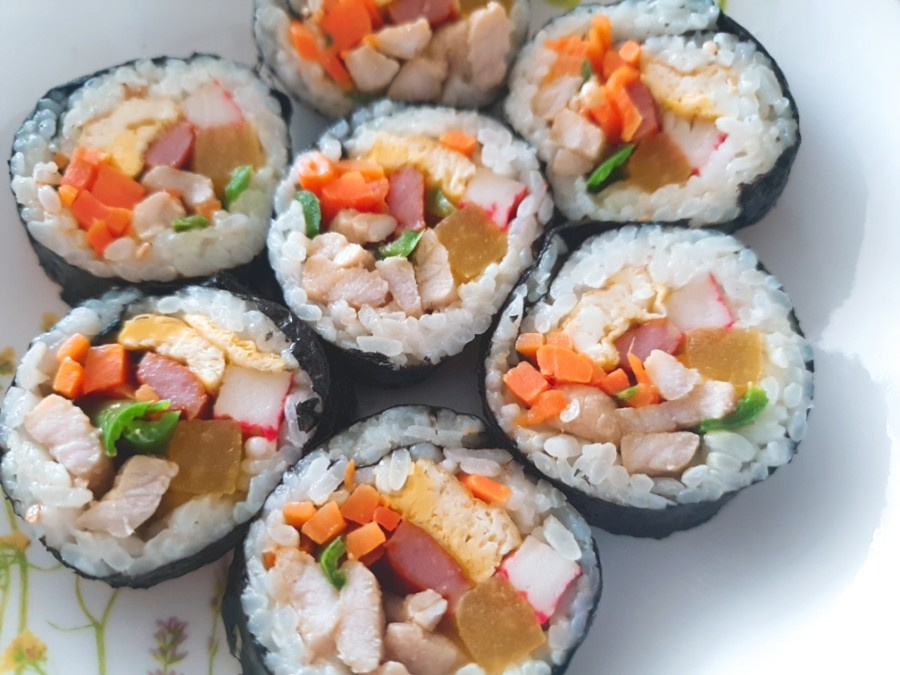Spicy Cheongyang Pepper Gimbap (Korean Rice Rolls)
Make Your Own Fiery Cheongyang Pepper Gimbap!

I don’t usually eat dishes with cheongyang peppers that often, but seeing someone eat this ‘Ttaengcho Gimbap’ on TV suddenly made me crave it! 😩 While buying it is convenient, finding a gimbap that suits my preference for spicy food can be difficult. So, I decided to buy the ingredients and make it myself. Let’s create this wonderfully flavorful and spicy gimbap together!
Main Ingredients- Gimbap seaweed sheets (set)
- Cooked rice (2 bowls)
- Pork for Japchae, 200g
- Cheongyang peppers, 3 (adjust to spice preference)
- Eggs, 4
- Carrot, 1/4
- Pickled radish (danmuji), as needed
Cooking Instructions
Step 1
I’m using 200g of pork, typically used for japchae, which should be enough to make about 4 rolls of gimbap. The exact number will depend on how much filling you add to each roll. First, we’ll marinate the pork before stir-frying it.

Step 2
In a bowl, combine the 200g of pork with 1 Tbsp oyster sauce, 1 Tbsp soy sauce, 1 Tbsp cooking wine, and a pinch of black pepper. Gently mix it all together, ensuring the marinade coats the pork evenly. Let it marinate while we prepare the other ingredients.

Step 3
Next, prepare the vegetables. Thinly julienne about 1/4 of a carrot. Heat a lightly oiled pan over medium-high heat and stir-fry the carrot strips until they are tender but still have a slight crispness. You want them pliable enough to roll.

Step 4
Crack 4 eggs into a bowl, whisk them thoroughly to break up the yolks and whites, and season lightly with salt if desired. Heat a lightly oiled non-stick pan over medium-low heat. Pour in the egg mixture to create a thin omelet. Cook until set, then flip and cook the other side until golden brown. Once cooked, let it cool slightly before cutting it into strips for the gimbap.

Step 5
If your gimbap set includes ham or imitation crab sticks, cut them into strips and lightly pan-fry them in a lightly oiled pan until golden brown. This adds a nice texture and flavor.

Step 6
Now, with the exception of the pork and the star ingredient, the cheongyang peppers, all our other fillings are ready! We just need to season the rice.

Step 7
Let’s prepare the spicy element: the 3 cheongyang peppers. Wash them thoroughly. Slice each pepper in half lengthwise and carefully remove all the seeds and membranes. Then, julienne the peppers into thin strips. If you like it extra spicy, you can leave some seeds in, but for a milder heat, remove them all.

Step 8
Add the marinated pork to a pan with a little cooking oil over medium-high heat. Stir-fry the pork until it’s fully cooked and no longer pink.

Step 9
Once the pork is cooked, add 1/2 Tbsp of minced garlic and stir-fry for another minute until fragrant. Then, add the julienned cheongyang peppers and continue to stir-fry until the peppers are tender-crisp and the pork is cooked through. Be careful not to overcook the peppers, as they can become mushy.

Step 10
No gimbap is complete without perfectly seasoned rice! Take 2 bowls of warm cooked rice and drizzle generously with 1 Tbsp of sesame oil. Add a pinch of salt and a pinch of toasted sesame seeds. Gently mix with a spatula, being careful not to mash the rice grains. The rice should be lightly seasoned – taste a little bit to check.

Step 11
Place a sheet of gimbap seaweed on a bamboo rolling mat. Spread about two-thirds of the seasoned rice evenly over the seaweed, leaving a small border at the top edge. Aim for a thin, even layer of rice.

Step 12
Arrange the stir-fried pork and cheongyang peppers, carrot strips, egg strips, ham (or imitation crab), and pickled radish in a line across the rice, near the bottom edge. Try to place the fillings evenly so the roll is balanced.

Step 13
Carefully lift the edge of the bamboo mat and roll the gimbap tightly, tucking in the fillings. Once rolled, let the gimbap sit for about 5 minutes before slicing. This allows the moisture from the rice to settle and the seaweed to become slightly more pliable, helping the roll hold its shape. Then, use a sharp knife to slice the gimbap into bite-sized pieces. Enjoy your homemade spicy Ttaengcho Gimbap!




